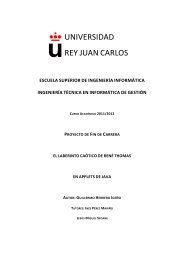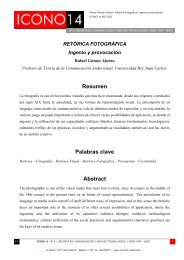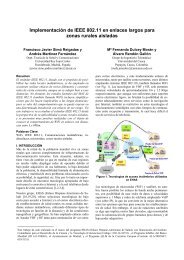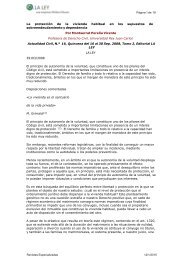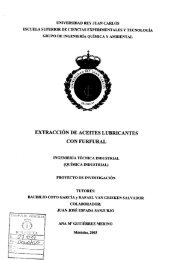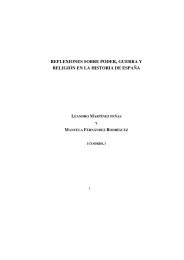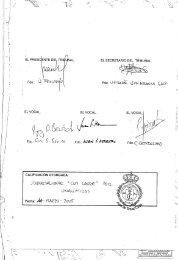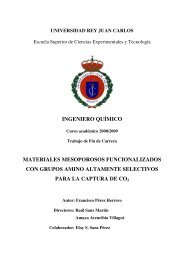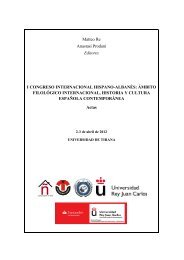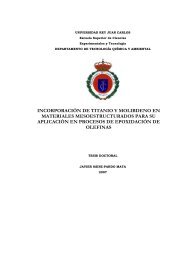- Page 1: Universidad Rey Juan Carlos Escuela
- Page 5: ―In theory, there is no differenc
- Page 9 and 10: Resumen Durante los últimos 20 añ
- Page 11 and 12: Acknowledgements First and foremost
- Page 13: Y no me olvido de mis amigos: nunca
- Page 16 and 17: XII 2.1.12.1 The Eclipse Modelling
- Page 18 and 19: XIV 2.4.3.2 Oxygen XML Editor .....
- Page 20 and 21: XVI 4.4.1 GPLs vs DSLs ............
- Page 22 and 23: XVIII 5.4 Code Generation in M2DAT
- Page 25 and 26: List of Figures Figure 1-1. MIDAS A
- Page 27 and 28: Figure 5-6. Partial view of the ORD
- Page 29 and 30: Figure 5-59. ATLDoc overview ......
- Page 31: List of Tables Table 2-1. OCL Expre
- Page 35 and 36: 1. Introduction In this thesis, a t
- Page 37 and 38: Introduction 33 As a result, there
- Page 39 and 40: Introduction 35 decisions and the d
- Page 41 and 42: Figure 1-1. MIDAS Architecture over
- Page 43 and 44: Introduction 39 Accordingly, M2DAT
- Page 45 and 46: Introduction 41 The continuation of
- Page 47 and 48: Resolution Validation MIDAS Methodo
- Page 49 and 50: Introduction 45 framework, capable
- Page 51: State of the Art
- Page 54 and 55: 50 Juan M. Vara 2.1 Previous Concep
- Page 56 and 57:
52 Juan M. Vara Metametamodel Metam
- Page 58 and 59:
54 Juan M. Vara In fact, it had bee
- Page 60 and 61:
56 Juan M. Vara map a model Ma into
- Page 62 and 63:
58 Juan M. Vara In some sense, code
- Page 64 and 65:
60 Juan M. Vara The Model Driven En
- Page 66 and 67:
62 Juan M. Vara Note also that MOF
- Page 68 and 69:
64 Juan M. Vara modelled with the n
- Page 70 and 71:
66 Juan M. Vara Besides, OCL allows
- Page 72 and 73:
68 Juan M. Vara quality user interf
- Page 74 and 75:
70 Juan M. Vara notice that not all
- Page 76 and 77:
72 Juan M. Vara want to be able to
- Page 78 and 79:
74 Juan M. Vara tool is able to gen
- Page 80 and 81:
76 Juan M. Vara 2.2.3 ATOM 3 ATOM 3
- Page 82 and 83:
78 Juan M. Vara Actually, EMF itsel
- Page 84 and 85:
80 Juan M. Vara extensible, but in
- Page 86 and 87:
82 Juan M. Vara packages. The user
- Page 88 and 89:
84 Juan M. Vara Furthermore, since
- Page 90 and 91:
86 Juan M. Vara offers support for
- Page 92 and 93:
Table 2-3. Frameworks and tools for
- Page 94 and 95:
90 Juan M. Vara As a conclusion we
- Page 96 and 97:
92 Juan M. Vara some of them aimed
- Page 98 and 99:
94 Juan M. Vara Language Transforma
- Page 100 and 101:
96 Juan M. Vara to know if it inclu
- Page 102 and 103:
98 Juan M. Vara transformation meth
- Page 104 and 105:
100 Juan M. Vara 2.3.3.4 GReAT GReA
- Page 106 and 107:
102 Juan M. Vara transformation lan
- Page 108 and 109:
104 Juan M. Vara 2.3.3.9 Tefkat Tef
- Page 110 and 111:
106 Juan M. Vara of writing this di
- Page 112 and 113:
108 Juan M. Vara the Eclipse GUI. T
- Page 114 and 115:
110 Juan M. Vara It provides accura
- Page 116 and 117:
112 Juan M. Vara transformation lan
- Page 118 and 119:
114 Juan M. Vara explicitly the rel
- Page 120 and 121:
116 Juan M. Vara standard, was addr
- Page 122 and 123:
118 Juan M. Vara from such review.
- Page 124 and 125:
120 Juan M. Vara 2.3.5.1 On Model-t
- Page 126 and 127:
122 Juan M. Vara Furthermore, its l
- Page 128 and 129:
124 Juan M. Vara We want to identif
- Page 130 and 131:
126 Juan M. Vara some degree of cus
- Page 132 and 133:
128 Juan M. Vara By the time of wri
- Page 134 and 135:
130 Juan M. Vara language, there is
- Page 136 and 137:
132 Juan M. Vara In essence, the OO
- Page 138 and 139:
134 Juan M. Vara In summary, HyperD
- Page 140 and 141:
136 Juan M. Vara [243] or Informix
- Page 142 and 143:
138 Juan M. Vara 2.4.3.6 Enterprise
- Page 144 and 145:
140 Juan M. Vara interface between
- Page 146 and 147:
Table 2-8. Tools supportinng Model-
- Page 148 and 149:
MT Table 2-9. Tools supporting (Mod
- Page 150 and 151:
146 Juan M. Vara Indeed, we have al
- Page 152 and 153:
148 Juan M. Vara XML Schema develop
- Page 155:
1 st Iteration: MIDAS-CASE
- Page 158 and 159:
154 Juan M. Vara From the very firs
- Page 160 and 161:
156 Juan M. Vara model conforms to
- Page 162 and 163:
158 Juan M. Vara 3.2.3.1 Using an X
- Page 164 and 165:
160 Juan M. Vara 3.3 MIDAS-CASE Pro
- Page 166 and 167:
162 Juan M. Vara DEFINITION objects
- Page 168 and 169:
164 Juan M. Vara 3.3.2 MIDAS-CASE4W
- Page 170 and 171:
166 Juan M. Vara identified in the
- Page 172 and 173:
168 Juan M. Vara one below. Althoug
- Page 174 and 175:
170 Juan M. Vara (parts). The compo
- Page 176 and 177:
172 Juan M. Vara from the W3C (http
- Page 178 and 179:
174 Juan M. Vara size, location, co
- Page 180 and 181:
176 Juan M. Vara MIDAS-CASE Metamod
- Page 182 and 183:
178 Juan M. Vara 3.4.2 XML Schema a
- Page 184 and 185:
180 Juan M. Vara 3.4.5 Model-Transf
- Page 187:
Solution: M2DAT Architecture and Te
- Page 190 and 191:
186 Juan M. Vara 4.1.1 M2DAT Concep
- Page 192 and 193:
188 Juan M. Vara plug-ins that comp
- Page 194 and 195:
190 Juan M. Vara discouraging outlo
- Page 196 and 197:
192 Juan M. Vara domain, a particul
- Page 198 and 199:
194 Juan M. Vara In an organization
- Page 200 and 201:
196 Juan M. Vara stakeholders in th
- Page 202 and 203:
198 Juan M. Vara MIDAS-CASE by deve
- Page 204 and 205:
200 Juan M. Vara Using these facili
- Page 206 and 207:
202 Juan M. Vara This way, the main
- Page 208 and 209:
204 Juan M. Vara diagrammers were e
- Page 210 and 211:
206 Juan M. Vara Finally, if we are
- Page 212 and 213:
208 Juan M. Vara In contrast, we ha
- Page 214 and 215:
210 Juan M. Vara revealed that this
- Page 216 and 217:
212 Juan M. Vara 4.5 Introducing De
- Page 218 and 219:
214 Juan M. Vara information that i
- Page 220 and 221:
216 Juan M. Vara metamodel directly
- Page 222 and 223:
218 Juan M. Vara The idea behind co
- Page 224 and 225:
220 Juan M. Vara 4.7 Model Validati
- Page 226 and 227:
222 Juan M. Vara was devised as a u
- Page 228 and 229:
224 Juan M. Vara Since constraints
- Page 230 and 231:
226 Juan M. Vara o Translate then t
- Page 232 and 233:
228 Juan M. Vara eSuperTypes 0..* e
- Page 234 and 235:
230 Juan M. Vara emf ECore MYDSL.ec
- Page 236 and 237:
232 Juan M. Vara Moreover, formaliz
- Page 238 and 239:
234 Juan M. Vara One minor comment
- Page 240 and 241:
236 Juan M. Vara -ownedElement 1 wo
- Page 242 and 243:
238 Juan M. Vara the vast majority
- Page 245:
Validation: M2DAT-DB
- Page 248 and 249:
244 Juan M. Vara following we intro
- Page 250 and 251:
246 Juan M. Vara the model. In this
- Page 252 and 253:
248 Juan M. Vara each MDE tasks tha
- Page 254 and 255:
250 Juan M. Vara First of all, note
- Page 256 and 257:
252 Juan M. Vara The Structural Com
- Page 258 and 259:
254 Juan M. Vara instance, if you h
- Page 260 and 261:
256 Juan M. Vara TABLE CUSTOMER ATT
- Page 262 and 263:
258 Juan M. Vara a serialized gener
- Page 264 and 265:
260 Juan M. Vara Figure 5-15. Using
- Page 266 and 267:
262 Juan M. Vara of the SQL:2003 bu
- Page 268 and 269:
264 Juan M. Vara inherits from Pred
- Page 270 and 271:
266 Juan M. Vara with this idea, M2
- Page 272 and 273:
268 Juan M. Vara Domain Model SQL20
- Page 274 and 275:
270 Juan M. Vara the Node Mapping T
- Page 276 and 277:
272 Juan M. Vara 5.3.1.1 One-to-One
- Page 278 and 279:
274 Juan M. Vara 5.3.1.3 Many-to-On
- Page 280 and 281:
276 Juan M. Vara could be used to i
- Page 282 and 283:
278 Juan M. Vara derived property a
- Page 284 and 285:
280 Juan M. Vara rule DerivedProper
- Page 286 and 287:
282 Juan M. Vara rule MultivaluedPr
- Page 288 and 289:
284 Juan M. Vara In this case, the
- Page 290 and 291:
286 Juan M. Vara intention of this
- Page 292 and 293:
288 Juan M. Vara rule SuperClassWit
- Page 294 and 295:
290 Juan M. Vara endpoint rule gene
- Page 296 and 297:
292 Juan M. Vara since the target t
- Page 298 and 299:
294 Juan M. Vara ATLDoc. It is base
- Page 300 and 301:
296 Juan M. Vara ATL File UML2SQL20
- Page 302 and 303:
298 Juan M. Vara Finally, matching
- Page 304 and 305:
300 Juan M. Vara most mature existi
- Page 306 and 307:
302 Juan M. Vara transformations is
- Page 308 and 309:
304 Juan M. Vara texttransformation
- Page 310 and 311:
306 Juan M. Vara We have opted for
- Page 312 and 313:
308 Juan M. Vara this case, the Sch
- Page 314 and 315:
310 Juan M. Vara UML2SQL2003 UML2OR
- Page 316 and 317:
312 Juan M. Vara private Transforma
- Page 318 and 319:
314 Juan M. Vara // launch AtlLaunc
- Page 320 and 321:
316 Juan M. Vara Figure 5-79. M2DAT
- Page 322 and 323:
318 Juan M. Vara launching the tran
- Page 325:
Conclusion
- Page 328 and 329:
324 Juan M. Vara O2. Analysis and e
- Page 330 and 331:
326 Juan M. Vara O6. Specification
- Page 332 and 333:
328 Juan M. Vara in the same techno
- Page 334 and 335:
330 Juan M. Vara Articles in Intern
- Page 336 and 337:
332 Juan M. Vara o Vara, J.M., De C
- Page 338 and 339:
334 Juan M. Vara In fact, we have a
- Page 340 and 341:
336 Juan M. Vara On the other hand,
- Page 342 and 343:
338 Juan M. Vara grammarware and M2
- Page 345:
Appendix A: Resumen en Castellano
- Page 348 and 349:
344 Juan M. Vara especificaciones d
- Page 350 and 351:
346 Juan M. Vara estar en condicion
- Page 352 and 353:
348 Juan M. Vara O1. Análisis y ev
- Page 354 and 355:
350 Juan M. Vara en cáscada [300]
- Page 356 and 357:
352 Juan M. Vara a medida que sean
- Page 358 and 359:
354 Juan M. Vara forma de mantener
- Page 361:
Appendix B: About Graph Transformat
- Page 364 and 365:
360 Juan M. Vara As Figure B-1 show
- Page 367:
Appendix C: Text-to-Model Transform
- Page 370 and 371:
366 Juan M. Vara automatically deri
- Page 372 and 373:
368 Juan M. Vara overcome this draw
- Page 375 and 376:
D Case Studiy This Chapter presents
- Page 377 and 378:
Figure D-2. Annotation Model for th
- Page 379:
Case Study 375 Figure D-4. OR Model
- Page 383 and 384:
E Bibliography References 1. Accele
- Page 385 and 386:
Bibliography 381 41. Bézivin, J. (
- Page 387 and 388:
Bibliography 383 81. Chaudhri, A.B.
- Page 389 and 390:
Bibliography 385 123. Efftinge, S.
- Page 391 and 392:
Bibliography 387 170. IBM. (2004).
- Page 393 and 394:
Bibliography 389 214. Landin, P. J.
- Page 395 and 396:
Bibliography 391 257. Musset, J. (2
- Page 397 and 398:
Bibliography 393 304. Salay, R., Ch
- Page 399 and 400:
Bibliography 395 348. Van Der Sluij
- Page 401:
Bibliography 397 391. XMLmodeling.c
- Page 405 and 406:
F Acronyms Table of Acronyms ACRONY
- Page 407:
ACRONYM DESCRIPTION SQL Structured



